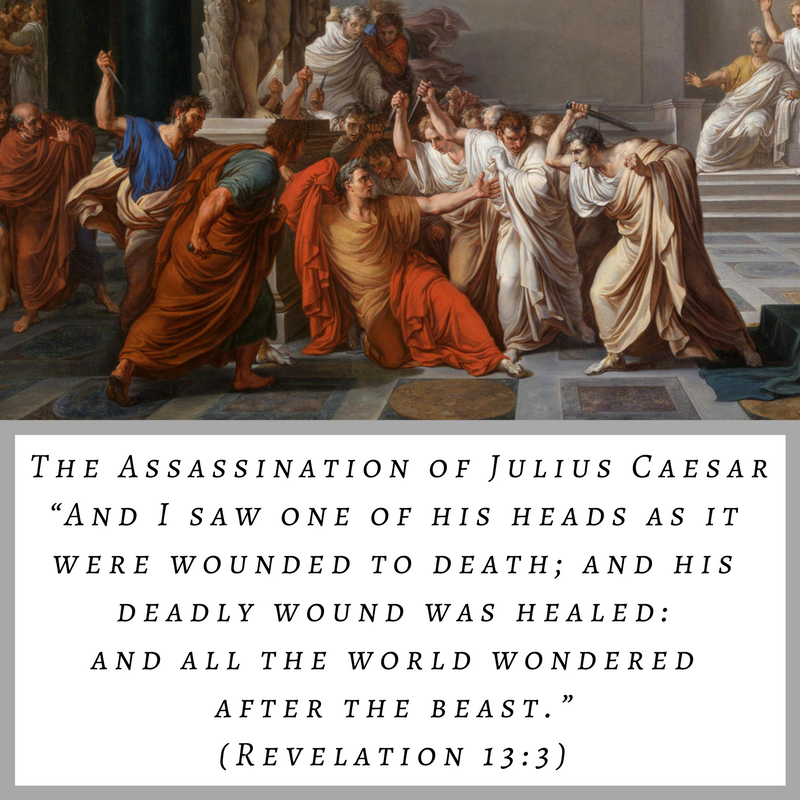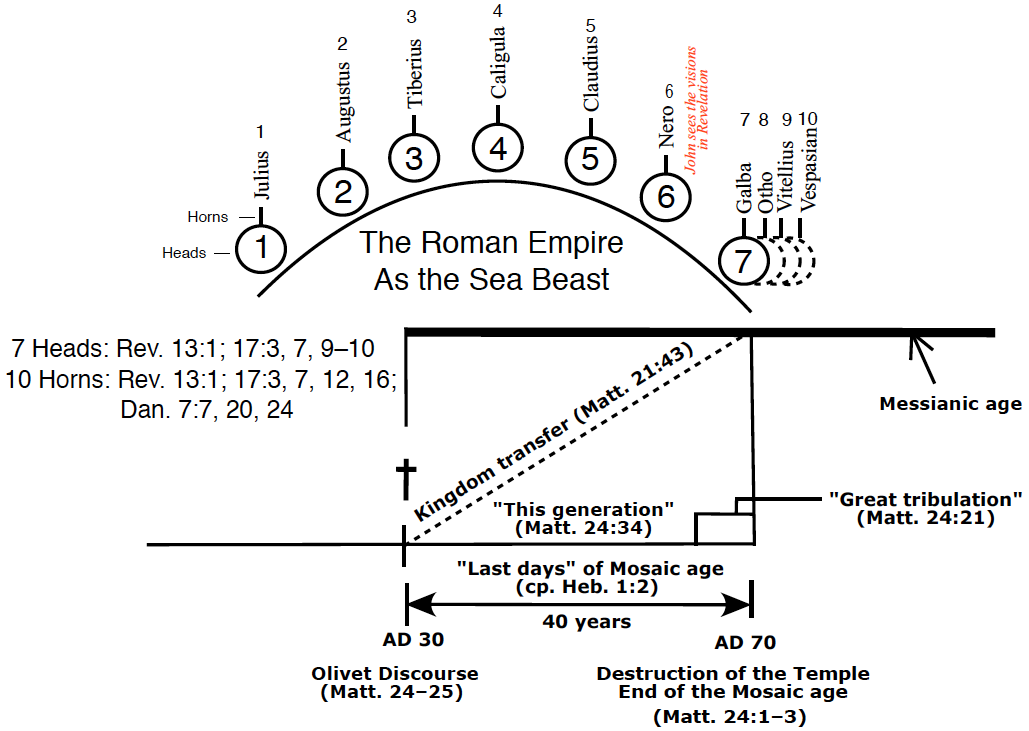
We need to chat about prophetic beasts. Our interpretation of Revelation using the inmillennial model requires it. They will play a major role in the rest of Revelation’s drama.
In an earlier post, we saw how the Seven Mystic1 Figures vision describes the generation between Jesus’s birth and the destruction of the Temple in AD 70.2 We have watched the Dragon (Satan) pursue the Woman into the wilderness after the Man-Child ascends to his throne in heaven.3 His first attack on the woman was foiled because the land helped her (Rev. 12:12–17). In this post, we will see the Dragon turn his sight across the Mediterranean to solicit help from a beast that rises out of the sea—the Sea Beast (Rev. 13:1–10).
Beasts represent kingdoms in biblical prophetic imagery. Five centuries before John saw “a beast rise up out of the sea” (Rev. 13:1), God gave Daniel a dream in which “four great beasts came up from the sea” (Dan. 7:3). These were four kings and their kingdoms (Dan. 7:17, 23).
These beasts were predators. The first three were: a lion (Dan. 7:4), a bear (Dan. 7:5), a leopard (Dan. 7:6). Daniel did not associate the fourth beast with a particular animal, but it was “dreadful and terrible, and strong exceedingly; and it had great iron teeth: it devoured and brake in pieces, and stamped the residue with the feet of it” (Dan. 7:7).
These represented the four major kingdoms between Daniel’s time and the coming of Christ. “In the successive rise and fall of the four empires of Babylon, Medo-Persia, Greece, and Rome, these destructive forces will exert their power through the centuries to come, till the final triumph of the Son of Man.”4
God would set up his kingdom during the time of the fourth (Roman) kingdom (Dan. 7:13–14, 19–22). The fourth beast had ten horns (Dan. 7:7) that represented the ten kings of that kingdom (Dan. 7:17, 23–24). In a previous vision, Daniel saw what God would do during this time: “And in the days of these kings shall the God of heaven set up a kingdom, which shall never be destroyed: and the kingdom shall not be left to other people, but it shall break in pieces and consume all these kingdoms, and it shall stand for ever” (Dan 2:44).
Jesus was born during the reign of Augustus, the second Roman Caesar5 (Luke 2:1). The Temple fell in AD 70 during the reign of Vespasian, the tenth Roman Caesar.6
These observations offer a rich background for our explanation of John’s Seven Mystic Figures vision using inmillennialism.
Exposition
After the Dragon didn’t destroy the Woman in the land, he stood on the sand of the sea (Rev. 12:17, ESV) as if to call for help.7 John sees a beast rise out of the sea. Based on Daniel’s beast vision, we suggest this beast is the Roman Empire, whose capital lay across the Mediterranean Sea from Israel’s coast. For this beast to help the Dragon pursue the Woman, it would “rise up out of the sea.”
John’s description reinforces this suggestion. The beast had seven heads and ten horns, and upon his horns ten crowns, and upon his heads the name of blasphemy (Rev. 13:1b). The beast’s heads and horns are mirror images of the Dragon’s (cp. Rev. 12:3) showing close allegiance. How does this describe the Roman Empire? Here is a tentative proposal.
The Sea Beast’s seven heads “are seven kings: five are fallen, and one is, and the other is not yet come; and when he cometh, he must continue a short space” (Rev. 17:9–10). John wrote Revelation near the start of the “great tribulation” (Rev. 7:14; cp. Matt. 24:21) known as the Jewish wars of AD 66–70. Five Roman Caesars “had fallen”—Julius, Augustus, Tiberius, Caligula, and Claudius. One “was”—Nero. When the other “came”—Galba—he reigned less than seven months.8 Thus, the “heads” represent the Roman kings up to the start of the “great tribulation.”
Daniel’s fourth beast—the Roman Empire—also had ten horns, each representing a king (Dan. 7:24). His vision involved God giving the kingdom to “the saints of the most high” (Dan. 7:27). Jesus associated this with the fall of the Temple (Matt. 21:43–45; cp. Dan. 9:26–27). This occurred in AD 70 during the reign of the tenth Roman Caesar. The “horns” represent the Roman kings unto the end of the “great tribulation.” Daniel’s vision matches John’s in this respect.
John may also distinguish between the Caesars who preceded the time of his writing Revelation from those who followed. As we have seen, he will distinguish the seventh (Galba) by noting his short reign (Rev. 17:10). Here, he distinguishes the last three by giving them a “horn,” but not a “head.” The Caesars up to John’s writing Revelation had both.
These “heads” and “horns” are on a single “beast.” Both represent kings of the Roman Empire. The difference between their counts draws attention to the same pivotal period we have seen in the other visions—the “great tribulation” that completed the transition from the Mosaic Age to the Messianic Age. Vespasian, the tenth Emperor, was on the throne when the Temple fell in AD 70.
The following diagram overlays the beast’s presence onto our inmillennial model.

John provides other links to Daniel’s beast prophecy. He says the beast which I saw was like unto a leopard, and his feet were as the feet of a bear, and his mouth as the mouth of a lion (Rev. 13:2). This is a composite of Daniel’s first three beasts but in reverse order. This shows the Roman Empire as the successor of the Grecian, Medo-Persian, and Babylonian empires. It was “the beast” in John’s generation.
Rome’s power came from Satan but was under God’s control. The dragon gave him his power, and his seat, and great authority. In Revelation, Satan uses the Roman empire to persecute Israel after the Spirit (e.g., Acts 13:50–14:7). God has other uses for the beast, however. He will use him to punish apostate Israel after the flesh as we shall see (D. V.).
The beast is invincible. John saw one of his heads as it were wounded to death; and his deadly wound was healed: and all the world wondered after the beast (Rev. 13:3). This fits our identification of the beast as the Roman Empire.
The head, or king, with a deadly wound was clearly Julius Caesar the founder of the Empire. And the wound of that head, the killing of Julius Caesar, did not kill the beast at all; the deadly wound was healed. Though Julius Caesar was killed as a protest against autocracy, it did not destroy it in the least; the Empire lived on, and Julius was followed by other Caesars more autocratic than he would have dared to be. The deadly wound was healed and the beast lived on to do the Devil’s work.9
After Julius’s murder,10 they worshipped the dragon which gave power unto the beast: and they worshipped the beast, saying, Who is like unto the beast? who is able to make war with him? (Rev. 13:4). The Roman Empire grew in power and imposed its will everywhere. From John’s perspective, it covered the entire world. None could resist its rule.
The beast was not neutral about divinities. Its Caesars demanded worship. And there was given unto him a mouth speaking great things and blasphemies (Rev. 13:5). Most people in the beast’s dominion gave it to them.
As we said, Satan ruled the beast, but God ruled Satan. And there was given to it authority to make war forty-two months (Rev. 13:5, YLT). Rome would wage war against Jerusalem, Israel after the flesh, and the Temple for three and one-half years during the “great tribulation.”
The beast continues to insult all things holy. And he opened his mouth in blasphemy against God, to blaspheme his name, and his tabernacle, and them that dwell in heaven. For example, Caligula, the fourth Caesar, gave an order to place his statue “in the Temple of Jerusalem. . . . The Temple of Jerusalem was then transformed into a temple for Caligula, and it was called the Temple of illustrious Gaius the new Jupiter.”11
John says it was given unto him to make war with the saints, and to overcome them (Rev. 13:7). The Roman empire fought against “the saints” in two senses. It made war with Israel after the Spirit12 and prevailed for a short while (cp. Acts 13–28).13 It then turned its attention to Israel after the flesh14 and destroyed it (Matt. 24:21; Rev. 7:14).
The beast controlled a vast area: power was given him over all kindreds, and tongues, and nations (Rev. 13:7). From Israel’s perspective, Rome governed the entire world (cp. Luke 2:1).
The beast will create a division in Israel. And all that dwell upon the [land15] shall worship him, whose names are not written in the book of life of the Lamb slain from the foundation of the world (Gk. kosmos) (Rev. 13:8). The elect in Israel followed Christ. The non-elect followed the beast and cried, “We have no king but Caesar” (John 19:15). Please see the diagram here.
John closes his description of the Sea Beast with a warning: If any man have an ear, let him hear. He that leadeth into captivity shall go into captivity: he that killeth with the sword must be killed with the sword. Here is the patience and the faith of the saints (Rev. 13:9–10). Apostate Israel—Israel after the flesh—chose to fight the beast (Rome) with carnal weapons and was destroyed. Faithful Israel—Israel after the Spirit—chose to fight with spiritual weapons and prevailed (cp. 2 Cor. 10:3–6).
Conclusion
Inmillennialism has allowed us to interpret the central figure (i.e., the beast) in Revelation’s central vision (i.e., The Seven Mystic Figures) in a straightforward and unforced manner. This adds to the accumulating evidence for its validity.
In our next post, we hope to consider the Dragon’s second recruit—the Land Beast. As you can see, beasts play a vital role in Revelation.
Footnotes
- Meaning “symbolic,” not “occult” throughout this post.
- The Seven Mystic Figures—Part 2: Exodus.
- The Seven Mystic Figures—Part 3: First Attack.
- Gleason L. Archer, Jr., “Daniel,” in The Expositor’s Bible Commentary: Daniel and the Minor Prophets (Grand Rapids, MI: Zondervan, 1986), 85.
- Modern scholars consider Augustus to be the first Roman emperor.
- Suetonius, The Twelve Caesars, (New York: Penguin Classics, 2007).
- For a discussion of whether “and I/he stood” ends chapter 12 or begins chapter 13, see Alan F. Johnson, “Revelation,” in The Expositor’s Bible Commentary: Hebrews Through Revelation (Grand Rapids, MI: Zondervan, 1981), 523.
- Suetonius, The Twelve Caesars, 254.
- David S. Clark, The Message From Patmos: A Postmillennial Commentary on the Book of Revelation, (Grand Rapids: Baker, 1989), 87. Other possibilities exist, including Nero’s suicide, as described by Steve Gregg, Revelation: Four Views: A Parallel Commentary, (Nashville: Thomas Nelson, 1997), 282-84.
- The digital file for the image at the beginning of this post (here) is in the public domain (PD-1923).
- “Wikipedia: Caligula,” Wikimedia Foundation, last modified November 27, 2017, 17:13, https://en.wikipedia.org/wiki/Caligula.
- Called “saints” in many places, including Acts 9:13, 32, 41, et al.
- Israel after the Spirit later defeated the beast.
- Also called “saints” in many places, including 1 Sam. 2:9; 2 Chron. 6:41; et al. For our two definitions of “Israel,” see the following posts: Israel: God’s Church Kingdom; False Jews And Their Persecutions; The Seven Mystic Figures — Part 1: Identities; and The Seven Mystic Figures — Part 2: Exodus.
- Per YLT. Gk gē.

1 comment
Wow! Bless your work!